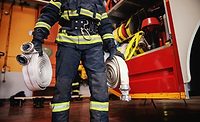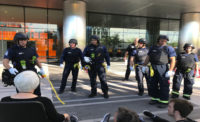DHS S&T seeks partners for First Responders technology R&D

The Department of Homeland Security (DHS) Science and Technology Directorate (S&T) is seeking new technologies for first responders. Industry, academia, laboratories and the innovation community are invited to submit proposals related to four technology categories through the Broad Agency Announcement (BAA) solicitation (BAA 18-02 Call 0002) until July 22, 2020.
“Now more than ever, our focus is on giving first responders of all disciplines the technology and personal protective equipment they need to do their jobs safely and effectively,” said Milt Nenneman, program manager in S&T’s Operations and Requirements Analysis Division. “We work directly with responders themselves to identify their capability gaps, which are reflected in these topics. We are now seeking the best partners to turn these needs into solutions.”
S&T is seeking proposals for these four topic areas:
- Integrated Structural Turnout Gear: Firefighters respond to a variety of response situations that require very specific turnout ensembles, garments, vests, and other items to meet the demands of the mission. Currently-available turnout gear does not inherently provide adequate visibility, ballistic protection, or lower extremity protection. S&T is seeking to provide firefighters with personal protective equipment that meet these needs and comply with all National Fire Protection Association standards for conventional firefighter missions.
- Next Generation Firefighter Helmet: Traditional structure firefighter helmets do not incorporate state-of-the-art technology that maximizes capability and safety. For instance, current helmets offer no ballistic protection, which puts firefighters at risk when working in violent situations. S&T is seeking a solution that will incorporate current “best of breed” capabilities and characteristics, including better head protection, increased comfort, increased range of motion, better retention, and less probability of snags, as well as easier cleaning and maintenance. The solution will adhere to National Institute of Justice Level IIIA ballistic protection.
- Remote and Rapid Rescue Capability: In the aftermath of a disaster, responders of all disciplines may have to locate and rescue people that are trapped in difficult-to-reach or dangerous-to-enter locations. Most traditional approaches can be time-consuming and often increase risk to the emergency responders themselves. Because time is of the essence, S&T is seeking new remote- and rapid-rescue tools that can quickly deploy an unmanned device or vehicle on the ground, in the water, and/or from the air to locate stranded or trapped persons, hook or load them, and carry them to safety. The proposed solution would also carry payloads to assist casualties by delivering food, water, medicine, or other supplies crucial to survival.
- Portable Thermal Imager Integrated with Signs-of-Life Sensors: Emergency responders need to quickly identify signs of life (e.g. breathing, blood pressure, body heat, pulse, movement, speech) to improve rescue and increase survival rates. Many existing tools are designed for large-scale events; S&T is seeking handheld options integrated with thermal imaging that the fire service, law enforcement, and emergency medical personnel can use in a wide variety of everyday operations. The solution would work in real time to locate people who are trapped, in distress, hiding or avoiding detection, or lost and could be deployed in a variety of operating environments.
Looking for a reprint of this article?
From high-res PDFs to custom plaques, order your copy today!





